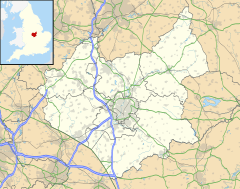Cold Newton facts for kids
Quick facts for kids Cold Newton |
|
|---|---|
 |
|
| OS grid reference | SK715066 |
| District |
|
| Shire county | |
| Region | |
| Country | England |
| Sovereign state | United Kingdom |
| Post town | LEICESTER |
| Postcode district | LE7 |
| Dialling code | 0116 |
| Police | Leicestershire |
| Fire | Leicestershire |
| Ambulance | East Midlands |
| EU Parliament | East Midlands |
| UK Parliament |
|
Cold Newton is a very small place in Leicestershire, England. It's called a hamlet, which is like a tiny village. It's also a civil parish, which is a local area used for government.
Cold Newton is located in the Harborough area. It sits about two miles from Tilton on the Hill and two miles north of Billesdon. This spot is quite high up, about 700 feet (213 meters) above sea level. From here, you can look down over the Wreake valley. Today, any people living nearby are counted as part of the Lowesby civil parish.
A Look Back in Time
Cold Newton has a long history, even though it's very small now. Its name was first written down as Niwetone in the Domesday Book. This was a huge survey of England ordered by William the Conqueror in 1086. It helped him understand who owned what land.
The name of the hamlet changed over time. It became Newton Burdett when Hugo de Burdet became the Lord of the Manor. A Lord of the Manor was like the main landowner and ruler of a local area. Later, it was also known as Newton Marmion when the Marmion family lived there. The lands of nearby Loseby and Quenby met right at Cold Newton.
Cold Newton Today
Today, Cold Newton is a deserted place. This means no one lives there anymore. You can still see signs of the old village in the fields. There are ridges and hollows, which are bumps and dips in the ground. These show where houses and streets used to be. The entire site is now a scheduled monument. This means it's a special historical place protected by law.
For local government, Cold Newton is connected with the Lowesby parish. It doesn't have a church, a pub, or any shops. However, a village green was created in 1977. This was to celebrate Queen Elizabeth II's Silver Jubilee. The land for the green was given to the parish by the Quenby estate.




